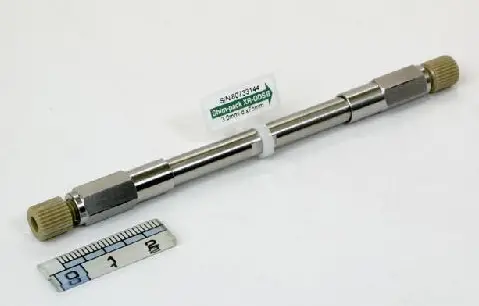In the realm of analytical chemistry, Octadecylsilane (ODS) and Base Deactivated Silane (BDS) columns are pivotal for achieving precise and reliable results in liquid chromatography. These columns, though similar in their fundamental purpose of separating chemical mixtures, differ significantly in their design and performance characteristics. The distinction between ODS and BDS columns can influence the outcome of chromatographic separations and is critical for chemists selecting the right tool for their analytical challenges.
ODS columns are typically used for general-purpose separations, featuring a silica-based material bonded with octadecylsilane, which makes them hydrophobic and suitable for non-polar compound retention. Conversely, BDS columns are designed with a base-deactivated silica that offers improved peak shapes for bases and reduces tailing, enhancing the accuracy of results in specific scenarios.
These two types of columns are engineered to meet the diverse needs of chemical analysis, where the choice of column can affect both the efficiency and specificity of the separation process. ODS columns are renowned for their versatility and robustness, making them a staple in many labs. BDS columns, however, provide specialized performance that is crucial when dealing with sensitive or complex samples.

Column Basics
ODS Columns
Definition and Characteristics
Octadecylsilane (ODS) columns, widely recognized in the field of chromatography, are built with a silica core chemically bonded to octadecylsilane groups. This bonding creates a hydrophobic surface, essential for reversed-phase chromatography. The columns generally exhibit high stability and durability, making them suitable for various analytical environments.
ODS columns are known for their high efficiency in separating non-polar compounds due to the non-polar nature of the bonded phase. Their robustness against acidic and neutral environments also marks a significant advantage, supporting their use across different pH levels without degradation.
Common Uses in Chromatography
ODS columns have broad applications in chromatography, including:
- Pharmaceutical analysis: Determining the purity of drugs and their degradation products.
- Environmental testing: Detecting contaminants like pesticides and herbicides in water samples.
- Food and beverage testing: Identifying additives, preservatives, and contaminants in food products.
BDS Columns
Definition and Characteristics
Base Deactivated Silane (BDS) columns are designed with a unique surface treatment of silica that minimizes interactions with basic analytes. This treatment effectively reduces peak tailing and improves the resolution of basic compounds, which are prone to interaction with residual silanol groups on untreated silica surfaces.
BDS columns stand out for their enhanced peak symmetry and reduced interaction with basic analytes, making them particularly suitable for sensitive analytical tasks where precision is paramount.
Key Applications
BDS columns are predominantly used in applications requiring high precision, such as:
- Biological samples: Analyzing compounds in biological matrices that may interact with untreated silica.
- Complex mixtures: Resolving closely eluting substances in pharmaceutical formulations.
- Sensitive analytical methods: Methods like high-performance liquid chromatography (HPLC) where peak shape and resolution are critical.
Material Composition
ODS Column Materials
Silica-Based Structures
The foundation of ODS columns is high-purity, porous silica gel. The silica used is typically spherical, with a controlled pore size that dictates the column’s selectivity and efficiency. The quality of silica impacts the reproducibility and performance of the column in separating analytes.
Bonding and Modifications
The silica surface in ODS columns is modified by bonding with octadecylsilane groups through a process called silanization. This process involves:
- Cleaning the silica surface to ensure it is reactive.
- Reacting the clean silica with a silane compound, typically in the presence of a solvent that promotes bonding.
This modification imparts the silica surface with hydrophobic properties, essential for reversed-phase chromatography.
BDS Column Materials
Enhanced Silica Properties
BDS columns utilize a base-deactivated silica, which undergoes a specific treatment to neutralize acidic sites that could interact with basic molecules. This treatment enhances the inertness of the silica, making it suitable for analyzing base-sensitive compounds.
Bonding Differences
The key difference in the bonding of BDS columns compared to ODS is the presence of a protective layer that shields the underlying silica from interacting with the analytes. This layer is typically created through:
- End-capping: Covering residual reactive silanol groups with methyl groups to reduce undesired interactions.
- Using bulkier silane agents: These agents create a steric hindrance that prevents the approach of base molecules to the silica surface.
Mechanism of Action
Retention Mechanisms in ODS
Interaction with Analytes
In ODS columns, retention is primarily governed by hydrophobic interactions between the non-polar analytes and the octadecylsilane-modified surface. The analytes temporarily adhere to the column’s surface based on their hydrophobicity, resulting in separation.
Role of Carbon Loading
The amount of carbon bonded to the silica, known as carbon loading, significantly affects retention. Higher carbon loading increases hydrophobicity, enhancing retention of non-polar compounds, thus allowing for a more effective separation process.
Retention Mechanisms in BDS
Improved Phase Stability
BDS columns offer improved phase stability, particularly in the analysis of basic compounds. The base-deactivation reduces interactions that could lead to peak tailing and loss of resolution, ensuring sharper and more symmetrical peaks.
Unique Interactions
Unlike ODS columns, BDS columns minimize secondary interactions with basic analytes through their specially treated surface. This leads to a more predictable and consistent retention behavior, crucial for complex or sensitive analyses.

Performance Comparison
Efficiency and Selectivity
Comparing Column Efficiencies
The efficiency of a chromatographic column can be measured by its ability to separate and resolve different compounds within a mixture. ODS columns typically exhibit high efficiency due to their uniform particle size and well-defined pore structure, which promote consistent flow and interaction patterns. BDS columns, while also efficient, are particularly enhanced to improve the peak symmetry for basic compounds, which can be challenging in ODS systems due to secondary interactions.
Selectivity Differences
Selectivity refers to a column’s ability to differentiate between various substances in a sample. ODS columns offer broad selectivity across a wide range of compounds, making them ideal for general applications. In contrast, BDS columns provide sharper selectivity for bases, benefiting analyses where compounds might otherwise exhibit poor peak shapes and co-elution in less specialized columns.
Stability and Durability
pH Range and Temperature Stability
ODS columns are known for their robustness across a variety of pH levels, typically ranging from 2 to 8. This allows for the analysis of acidic, neutral, and slightly basic compounds without significant degradation of the column material. BDS columns, however, are often rated for a slightly narrower pH range, focusing on environments where base-sensitive interactions are minimized.
Temperature stability is also critical, especially in high-throughput labs where columns must endure varied thermal conditions. Both ODS and BDS columns are designed to withstand temperatures commonly used in high-performance liquid chromatography (HPLC), maintaining integrity and performance up to about 60°C.
Lifespan Under Various Conditions
The lifespan of chromatographic columns is influenced by their usage, cleaning protocols, and sample types. ODS columns are generally durable, with a lifespan that supports extensive use when properly maintained. BDS columns, while equally durable under optimal conditions, may require more careful handling to preserve the specialized surface properties that are critical for their performance.

Application Scenarios
ODS in Practice
Common Compounds Analyzed
ODS columns are versatile and widely used for a variety of compounds, including:
- Lipophilic substances: Efficient in separating fats, oils, and other non-polar compounds.
- Pharmaceuticals: Robust in handling a range of drug substances and their metabolites.
- Environmental pollutants: Effective in tracing non-polar contaminants such as PCBs and PAHs.
Industry-Specific Applications
Due to their reliability, ODS columns are preferred in industries such as:
- Pharmaceuticals: For drug development and quality control.
- Environmental science: For monitoring water and soil samples.
- Food and beverage: For ensuring compliance with safety standards.
BDS in Practice
Unique Advantages
BDS columns are specially tailored to enhance the analysis of basic compounds, providing:
- Reduced tailing: Crucial for accurate quantification.
- Improved resolution: Essential for closely eluting compounds.
Preferred Industries
BDS columns are particularly valuable in:
- Clinical research: Where precision is critical for patient safety.
- Forensic analysis: Offering high sensitivity for toxicological screenings.
Advantages and Limitations
Benefits of ODS Columns
Versatility and Reliability
ODS columns are renowned for their ability to handle a wide array of chemical analyses, making them indispensable in many labs. Their robust nature ensures reliable results across various applications.
Cost-Effectiveness
Due to their broad applicability and long lifespan, ODS columns represent a cost-effective choice for many laboratories, minimizing the need for specialized columns.
Benefits of BDS Columns
Enhanced Performance Metrics
BDS columns offer superior performance in the analysis of basic compounds, providing:
- Sharper peaks: For better quantification and identification.
- Reduced matrix effects: Enhancing analytical accuracy.
Specialized Application Benefits
The specific enhancements of BDS columns make them ideal for applications requiring high precision and sensitivity, particularly in pharmaceutical and clinical settings.
Choosing the Right Column
Factors to Consider
Selecting the right chromatographic column involves considering:
- Sample type: Understanding the chemical nature of the sample.
- Analytical requirements: Determining resolution, sensitivity, and throughput needs.
- Column compatibility: Matching the column’s specifications with the HPLC system and conditions.
Case Studies and Examples
Examining real-world applications can illustrate the effectiveness of column selection:
- Pharmaceutical analysis: A case study where an ODS column was used to identify impurities in a new drug formulation.
- Environmental testing: How a BDS column was crucial in detecting low levels of toxic chemicals in drinking water.
FAQs
What are ODS columns?
ODS columns are packed with silica gel chemically bonded with octadecylsilane groups. This modification provides a hydrophobic surface, making them ideal for reversed-phase chromatography, where they excel in separating non-polar compounds.
How do BDS columns differ from ODS columns?
BDS columns feature a base-deactivated silica surface, which is specifically designed to improve peak shapes for basic compounds and reduce tailing effects. This makes BDS columns particularly effective in scenarios where analyte stability and precision are paramount.
When should I use an ODS column?
An ODS column is typically employed when you need a robust and versatile option for separating a wide range of compounds, especially non-polar molecules, in various samples including pharmaceuticals, environmental samples, and foods.
What are the advantages of BDS columns?
BDS columns offer enhanced performance for basic compounds by minimizing peak tailing and providing sharper peak shapes. They are particularly beneficial in complex matrices where resolving closely eluting compounds is crucial.
Conclusion
The careful selection of either an ODS or a BDS column can significantly impact the analytical results in liquid chromatography. Understanding the unique attributes of each column type not only empowers chemists to choose the most appropriate column for their specific needs but also enhances the overall reliability and accuracy of their analytical procedures.
In conclusion, while ODS columns offer broad applicability and robustness, making them a default choice for many routine applications, BDS columns provide specialized capabilities that are essential for high-precision analysis. This knowledge enables laboratories to optimize their chromatographic conditions for superior analytical outcomes.

